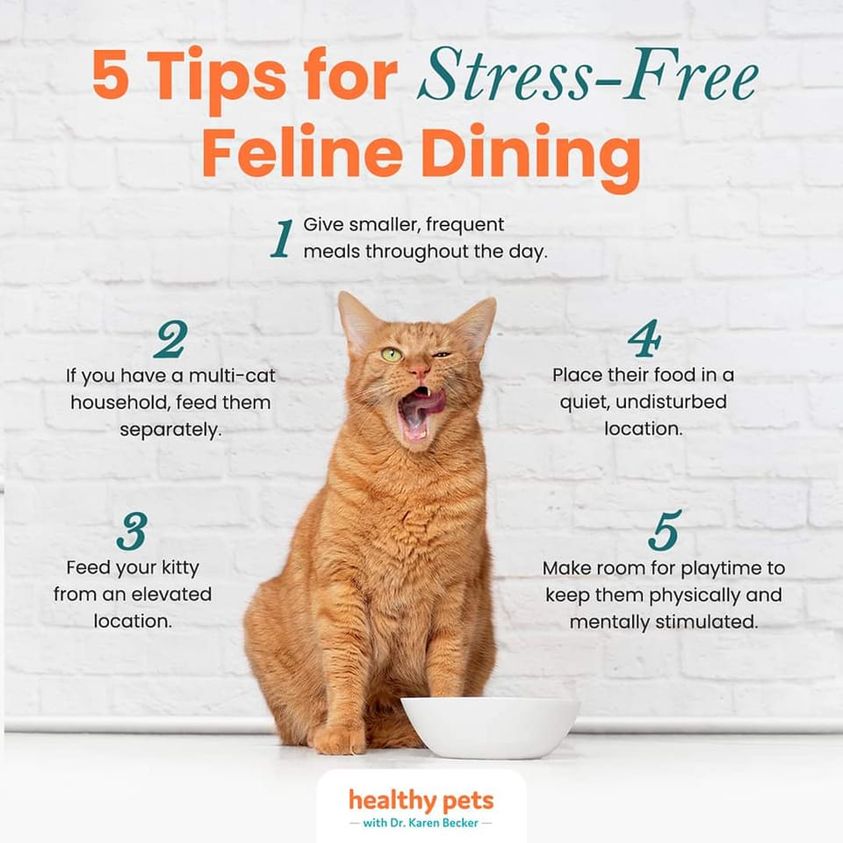
ANIMALS 101 – HOW YOU CAN ENCOURAGE A RELUCTANT EATER.
Last week we looked at some tips for when your cat is reluctant to drink and today we will look at some tips for reluctant eaters. Cats’ ancestral diet was moisture-rich prey which helps meet their fluid requirements, so feeding your cat dry food only, which is <10% water, can create a problem. It can cause chronic dehydration, leading to constipation and kidney stress, which is why vets recommend feeding cats moisture-rich diets. One of the first signs that a feline family member is sick is a lack of appetite. Cats can’t go without food for very long due to the risk of hepatic lipidosis, so it’s important to address the problem quickly.
TWO MAIN REASONS WHY YOUR CAT MIGHT NOT BE EATING.
- STRESS
Cats who are stressed can lose their appetite. Has something in your cat’s life changed?
- New family members (human or animal)?
- Have you moved?
- Sometimes it can be too few resources or the placement thereof. We suggest a water and food bowl for each cat plus an extra one, as well as with the litter box and neither the bowls or the litter box should be placed close to the other.
This is a situation pet parents can often resolve without consulting a veterinarian.
2. UNDERLYING ILLNESS
Several underlying diseases can cause kitties to lose interest in eating and it’s important to contact your veterinarian right away if you suspect your cat is ill. Remember not all vets are good with cats, so find one with a special interests in cats.
Also read: DA in GMM to take legal action to remove Speaker
TIPS TO TEMPT KITTY’S TASTEBUDS (Dr. Karen Becker & The Cat Nurse)
There are things you can do to try to entice your cat to eat; however, veterinary intervention is necessary if, despite your best efforts, your cat isn’t eating. Helping a cat who is refusing to eat stay nourished is an exercise in creativity, gentle prodding, and patience.
- Warm her meals to bring out the aroma as cats respond to the smell of food before the taste.
- Lure her with species-appropriate “people food” she has enjoyed in the past, for example, warm baked chicken or salmon.
- Offer her canned food with a strong smell or a sardine (packed in water).
- Buy a small selection of different flavours and textures of canned cat food or use home-cooked meat or bone broth and see if one catches her interest.
- If she’s hooked on kibble and refuses everything else, try adding warm water to the food or an aromatic enticement like tuna juice or chicken broth.
- Double bowls tend to be small, quite deep and are of course joined together, which could risk aggravating your cat’s sensitive whiskers. Try using a large flat bowl that gives plenty of room for your cat’s whiskers. Offer new food from a paper plate (in case she associates a bad memory with her food bowl). Whisker fatigue plays a role if the bowl is too small or deep.
- If you are changing your cat’s food bowl, offer food in the old bowl and original location as well as using the new bowl and in a slightly different location. This allows your cat to have a choice. You can then remove the old bowl once your cat starts using the new one.
- Raised bowls can help encourage some cats to eat. This means that your cat doesn’t have to dip its head down into the bowl to eat or drink, meaning he/she can still keep watch for any threats. Consider raising the bowl, especially if your cat is elderly and/or has arthritis as it may be more comfortable for your cat to eat that way (less pressure on its joints and less flexion of the neck).
- Consider offering food in ceramic or glass bowls. Plastic holds odours and metal is reflective.
- Keep the food and water stations separate. Being survivalists, cats like to eat in one place and drink in another. Cats living in the wild do this to prevent food (blood and tissue from prey) from contaminating their water (a sick cat is a vulnerable cat) and because it helps to keep the location of their food (and them) a secret.
STILL NOT EATING?
If despite your best efforts you can’t get sufficient calories into your cat, call your veterinarian, who may prescribe an appetite stimulant, a homeopathic remedy, or a vitamin B12 injection.

5 TIPS FOR STRESS-FREE FELINE DINING IN GENERAL (Dr. Karen Becker)
- Offer food in a variety of ways that gives your cat more control over her environment. When possible, feed smaller, frequent meals throughout the day, instead of two larger meals. Use food puzzles, hunting feeders, or other novel methods that encourage her to actively look for food and burn calories in the process.
- In a multi-cat household, feed everyone separately. Establish multiple feeding locations that provide solitary access to food. Food puzzles, hunting feeders and regular bowls/saucers containing small amounts of food can be placed in different spots around the house to help satisfy the natural feline desire to dine in different locations. It also encourages cats to spend time hunting for food and allows them to be in control of their food intake.
- If feasible, feed your kitty from an elevated location, since cats tend to feel safer in high spots where they can see what’s going on around them. These platforms should only be large enough for one cat. Do not put their bowls in a corner as they feel safer when they can view the area for threats, as in nature.
- Try to place your cat’s food in areas with minimal human activity and away from loud noises and visual threats like a window where your kitty might catch a glimpse of another cat outside.
- Put food in locations that encourage climbing and set aside time to play with your cat each day, which will provide him with both physical and mental stimulation.
CHECK THE POOP
It sounds weird to some, but it is important to regularly check their poop as it can indicate health concerns. Watch this video about it. Urine is discussed with drinking in last weeks’ article.
Keep your cat healthy and fed by following these tips. Next week we will look at post-operative care for your pet.
WHEN YOU KNOW BETER, DO BETTER!
#cats #reluctanteater #cattips #cathealth #catbehaviour #catfood